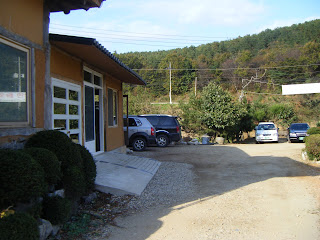
LIFE is SHORT, BUT U MAKE ME FEEL it LONG
n this space, i was running with time together. i was a good runner and the sun , the moon and the stars were shining brightly above me. as time goes on, the space seems to be expending, maybe because the time of history is longer too. one more day passed by, i am shreiking in the pompous space. what is the meaning of time? for an individual, time means a lot. in one's life, from the moment we were born into this world, more exactly, we were already nearing to death in the womb of our mothers'. our mother natured us , with full of motherly love, while we grew up with the growing dreams and grew mature with the wakeness from the dreams.
sometimes it was too good to wake up from the dream. sometimes it was too scary to wake up from the nightmare. we were screaming and struggling for life, for dignity, for a little more safety.
we were lost, but we were making good times. while i was always lost and got myself trapped.
it was wet outside but no rain, it was cold but no ice, it was time but overcame by space. someone is in love, so forever becomes only present moment.
my head was split into two pieces. two pieces were swirling, i could not pick them up. like the autum leaves, i was withering silently.

ove Hubble Working Again
(Oct. 30) - After overcoming a glitch that had forced science operations to cease, operators wasted no time in using the Hubble Space Telescope to photograph another stunning cosmic scene.
The new image, released today, shows an odd pair of galaxies called Arp 147.
Transmission problems on the Hubble Space Telescope have been fixed. As proof that it's working, NASA on Thursday released this undated photograph showing the aftermath of two galaxies known as Arp 147 colliding. The reddish-colored galaxy has passed through an O-shaped galaxy that glows blue.
In the image, a galaxy at left looks somewhat like the number "1" and is relatively undisturbed, but for a smooth ring of starlight. It appears nearly edge-on to our line of sight. A galaxy at right, looking like a "zero," exhibits a clumpy, blue ring of intense star formation.
Mission officials suggested the image is a perfect "10." It shows that the observatory's Wide Field Planetary Camera 2 (WFPC2) is working exactly as it did before going offline.
The blue ring was formed after the galaxy on the left passed through the galaxy on the right. Just as a pebble thrown into a pond creates an outwardly moving circular wave, or ripples, an outwardly propagating ring of higher density was generated at the point of impact of the two galaxies, astronomers explained. As this excess density collided with outer material that was moving inwards due to the gravitational pull of the two galaxies, shocks and dense gas were produced, stimulating star formation.
The dusty reddish knot at the lower left of the blue ring probably marks the location of the original nucleus of the galaxy that was hit.Arp 147 appears in the Arp Atlas of Peculiar Galaxies, compiled by Halton Arp in the 1960s and published in 1966.
Arp 147 lies in the constellation of Cetus, more than 400 million light-years from Earth.The Sept. 27 failure of a vital data relay channel left the 18-year-old Hubble telescope unable to transmit the bulk of its science data and imagery. The channel, the Side A relay of Hubble's Science Instrument Control and Data Handling system, had been working properly since the telescope launched in April 1990.
Efforts to switch to a backup Side B channel last week met with challenges of their own, with two separate glitches thwarting the initial attempt. But a second try appears to have been successful, with Hubble engineers reactivating the telescope's main science instruments over the last week.
The remote control fix required engineers to power up and switch to backup systems that had been hibernating since Hubble launched into space.
Hubble's September data relay channel failure prompted NASA to delay a planned Oct. 14 space shuttle launch to send seven astronauts to the orbital observatory on a fifth and final service call to the telescope. That mission is now slated to fly no earlier than February, with Hubble engineers testing a spare data relay channel to see if it can be added to the shuttle's cargo bay and be installed during the flight.
Hubble officials are expected to give an update today at 5:00 p.m. EDT (2000 GMT) on plans for the servicing mission. The service call is expected to include five spacewalks to add a new camera, upgrade guidance equipment, replace aging batteries and gyroscopes, deliver a docking ring and include repairs for systems never designed to be repaired in space.
The final Hubble overhaul is expected to extend the space telescope's mission lifetime through at least 2013, mission managers have said.
n this space, i was running with time together. i was a good runner and the sun , the moon and the stars were shining brightly above me. as time goes on, the space seems to be expending, maybe because the time of history is longer too. one more day passed by, i am shreiking in the pompous space. what is the meaning of time? for an individual, time means a lot. in one's life, from the moment we were born into this world, more exactly, we were already nearing to death in the womb of our mothers'. our mother natured us , with full of motherly love, while we grew up with the growing dreams and grew mature with the wakeness from the dreams.
sometimes it was too good to wake up from the dream. sometimes it was too scary to wake up from the nightmare. we were screaming and struggling for life, for dignity, for a little more safety.
we were lost, but we were making good times. while i was always lost and got myself trapped.
it was wet outside but no rain, it was cold but no ice, it was time but overcame by space. someone is in love, so forever becomes only present moment.
my head was split into two pieces. two pieces were swirling, i could not pick them up. like the autum leaves, i was withering silently.

ove Hubble Working Again
(Oct. 30) - After overcoming a glitch that had forced science operations to cease, operators wasted no time in using the Hubble Space Telescope to photograph another stunning cosmic scene.
The new image, released today, shows an odd pair of galaxies called Arp 147.
Transmission problems on the Hubble Space Telescope have been fixed. As proof that it's working, NASA on Thursday released this undated photograph showing the aftermath of two galaxies known as Arp 147 colliding. The reddish-colored galaxy has passed through an O-shaped galaxy that glows blue.
In the image, a galaxy at left looks somewhat like the number "1" and is relatively undisturbed, but for a smooth ring of starlight. It appears nearly edge-on to our line of sight. A galaxy at right, looking like a "zero," exhibits a clumpy, blue ring of intense star formation.
Mission officials suggested the image is a perfect "10." It shows that the observatory's Wide Field Planetary Camera 2 (WFPC2) is working exactly as it did before going offline.
The blue ring was formed after the galaxy on the left passed through the galaxy on the right. Just as a pebble thrown into a pond creates an outwardly moving circular wave, or ripples, an outwardly propagating ring of higher density was generated at the point of impact of the two galaxies, astronomers explained. As this excess density collided with outer material that was moving inwards due to the gravitational pull of the two galaxies, shocks and dense gas were produced, stimulating star formation.
The dusty reddish knot at the lower left of the blue ring probably marks the location of the original nucleus of the galaxy that was hit.Arp 147 appears in the Arp Atlas of Peculiar Galaxies, compiled by Halton Arp in the 1960s and published in 1966.
Arp 147 lies in the constellation of Cetus, more than 400 million light-years from Earth.The Sept. 27 failure of a vital data relay channel left the 18-year-old Hubble telescope unable to transmit the bulk of its science data and imagery. The channel, the Side A relay of Hubble's Science Instrument Control and Data Handling system, had been working properly since the telescope launched in April 1990.
Efforts to switch to a backup Side B channel last week met with challenges of their own, with two separate glitches thwarting the initial attempt. But a second try appears to have been successful, with Hubble engineers reactivating the telescope's main science instruments over the last week.
The remote control fix required engineers to power up and switch to backup systems that had been hibernating since Hubble launched into space.
Hubble's September data relay channel failure prompted NASA to delay a planned Oct. 14 space shuttle launch to send seven astronauts to the orbital observatory on a fifth and final service call to the telescope. That mission is now slated to fly no earlier than February, with Hubble engineers testing a spare data relay channel to see if it can be added to the shuttle's cargo bay and be installed during the flight.
Hubble officials are expected to give an update today at 5:00 p.m. EDT (2000 GMT) on plans for the servicing mission. The service call is expected to include five spacewalks to add a new camera, upgrade guidance equipment, replace aging batteries and gyroscopes, deliver a docking ring and include repairs for systems never designed to be repaired in space.
The final Hubble overhaul is expected to extend the space telescope's mission lifetime through at least 2013, mission managers have said.



















































